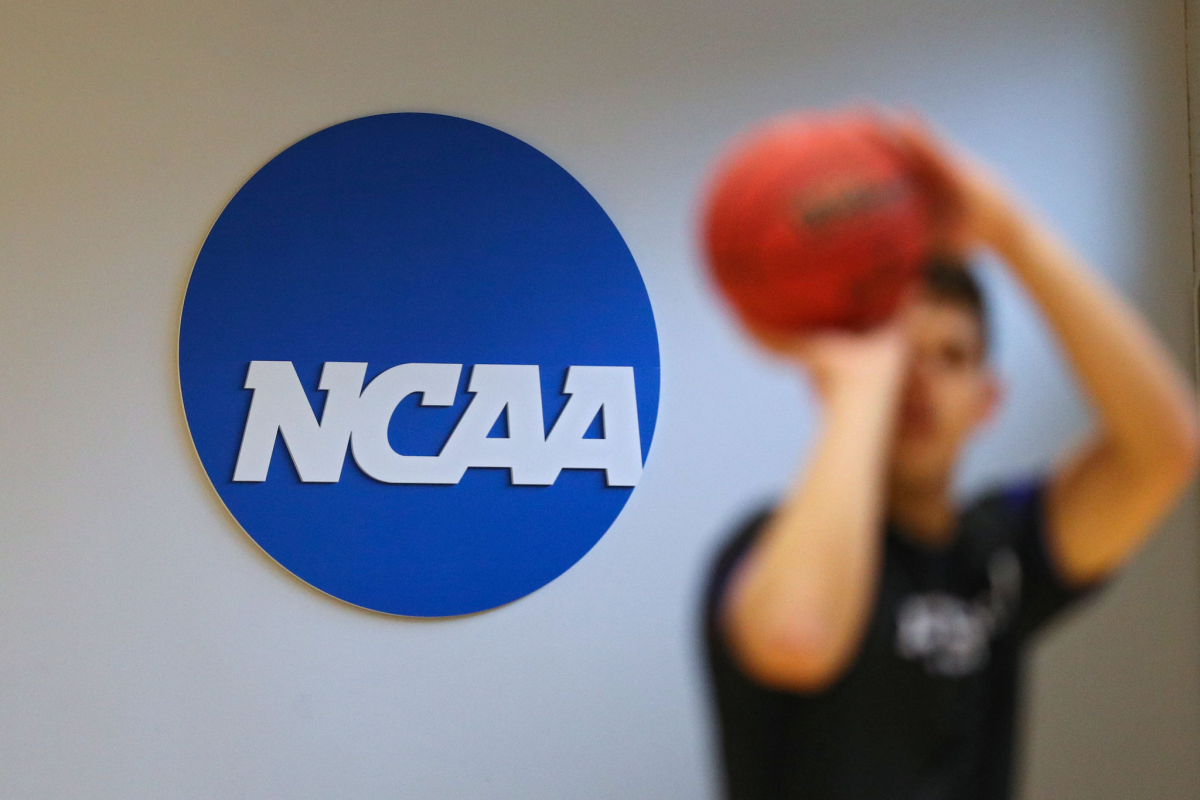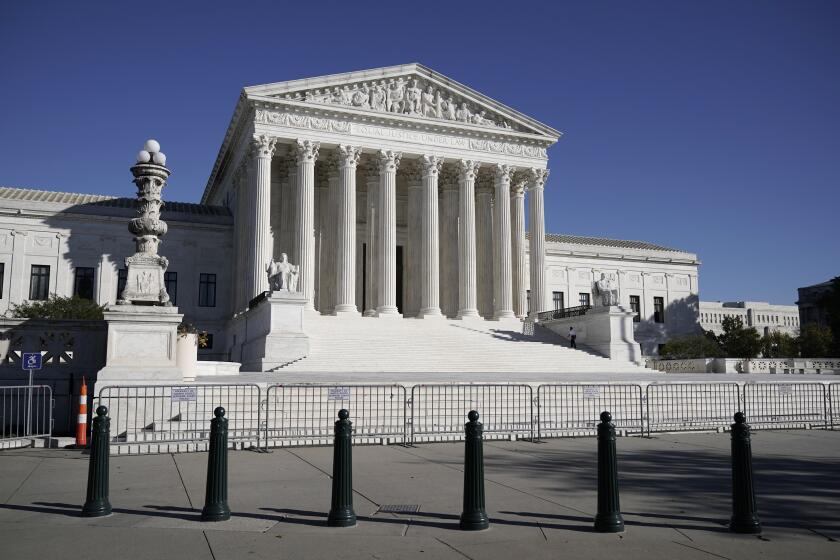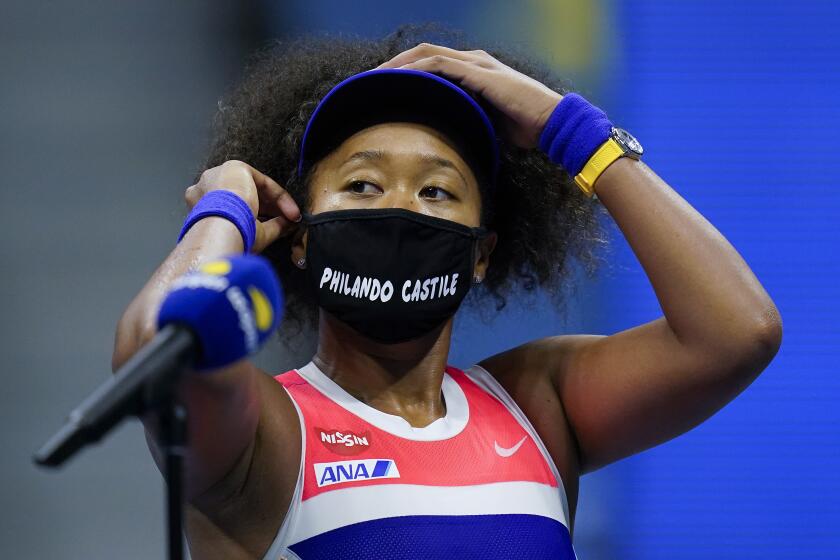If Supreme Court rules against NCAA athlete compensation, the fight must not end

- Share via
What makes someone a professional?
Is it the mere distribution of a paycheck or are there other factors, such as the person’s unique level of expertise or their contributions to a company or enterprise? It makes sense that a multibillion-dollar industry is only a multibillion-dollar industry because of the competency of professionals and not a collection of “amateurs.”
This the moral, and economic, question at the heart of the NCAA’s longstanding reluctance to pay student-athletes.
This week the Supreme Court decided to deliberate the legal one.
Earlier this year the 9th Circuit Court of Appeals ruled that the NCAA’s limits on compensation violated federal antitrust law. Dozens of states, including California, either have passed or are working on bills that would prevent the NCAA from blocking student-athletes from cashing in on their fame.
The Supreme Court has agreed to rule on whether the NCAA can cap the education-related money that student athletes receive.
The NCAA is hoping a favorable Supreme Court ruling would at the very least delay what would be a seismic change in the way it has done business since John McKay’s integrated USC football team went down to Alabama a half-century ago and whupped Bear Bryant’s all-white Crimson Tide 42-21. Back then the average Division I athletic department raked in $6.5 million. In 2019, Alabama coach Nick Saban alone made $8.7 million. In 2018, Alabama’s athletic department raked in $177.5 million, with the football program accounting for $111.1 million.
And the players? They’re amateurs, non-professionals, they don’t get paid.
“It’s a fairly strong argument that the NCAA rule could violate antitrust law,” said Sunny Hostin, ABC’s senior legal analyst and a former trial lawyer in the Justice Department’s antitrust division. “When you look at the revenue these students are generating, it’s a ridiculous premise.”
How can anyone continue to defend this blatant, indentured servitude? And don’t counter with the tuition-room-and-board argument, which is barter, not compensation. Not to mention a lazy, flawed argument.
The two sports dominated by Black and brown bodies — football and men’s basketball — are also the two sports directly responsible for 58% of the revenue generated by Football Bowl Subdivision schools. Football and basketball in Power 5 schools not only pay for new buildings and seven-figure salaries in the athletic department, but a recent study by the National Bureau of Economic Research lays out how they also have been supporting the non-revenue sports that mostly are populated by their rich, white counterparts. Sports such tennis, crew and sailing.
In a year in which several institutions are re-evaluating their practices as they relate to equality — including this week’s announcement that MLB will reclassify the Negro Leagues and their record books as major league — it’s time for the NCAA to address the immoral wealth gap it has created. And ignored.
California’s landmark Senate Bill 206, which allow college athletes to profit from the use of their name, image and likeness, could go into effect a year earlier.
Agreeing to hear a case is one step. The last NCAA issue to reach the Supreme Court was in 1984, seven years before the current longest-sitting justice, Clarence Thomas, was confirmed. Parsing how the Court will rule is a whole other. Yes, the NCAA’s defense of amateurism is repugnant and immoral, but is it illegal or unconstitutional?
“The rapid shift of the court over President Trump’s term in office has made it such that these new justices are going to be exploring this issue for the first time,” said Chris Geidner, a former Supreme Court reporter for BuzzFeed and now director of strategy for the nonprofit organization The Justice Collaborative.
Geidner pointed to the split between two of Trump’s three appointees, Justices Neil Gorsuch and Brett Kavanaugh, on a high-profile 2019 antitrust ruling involving Apple as evidence that “we could be very surprised by their views of how colleges treat student-athletes.”
Thomas Jefferson once said “If a law is unjust, a man is not only right to disobey it, he is obligated to do so.” While that quote is at odds with his ownership of hundreds of slaves at Monticello, the spirit of what he said stands. If the Supreme Court does not rule in the college athletes’ favor, I hope that doesn’t mean they will cease to fight.
The Supreme Court once upheld segregation in Plessy vs Ferguson in 1896 before the ruling was effectively overturned in 1954 by the Brown v Board of Education ruling. I’m not suggesting it could take another 58 years before the NCAA system finally is corrected. I’m saying if the fighting stopped after the 1896 decision, there would not have been one in 1954.
Disingenuous choruses of ‘stick to sports’ — as if race and sports have ever been separate issues — rang particularly hollow this year.
There would not have been an all-Black starting lineup at Texas Western College to beat segregationist Adolf Rupp and his all-white Kentucky Wildcats for the 1966 NCAA basketball championship. There would not have been an integrated USC football team to embarrass Bryant and forever change the Southeastern Conference, and by extension the entire sport, in 1970.
If, by chance, the Supreme Court upholds an unjust law, student-athletes are obligated to disobey. To fight.
When the NCAA was founded in 1910, college sports was not a revenue-generating business. Amateurism could be defended with a straight face. In 2020 the NCAA is a business colossus trying to recoup lost billions on the backs of poor young men, many of them Black and brown, supporting rich white men asking those unpaid laborers to play ball in the midst of a pandemic that has killed more than 300,000 Americans.
It’s an unbalanced power structure, one that takes advantage of some of our most vulnerable. That’s not the legal argument, that’s the moral one. How the Supreme Court rules is anyone’s guess, but when it comes to matters of both the heart and common sense, the verdict was submitted years ago.
More to Read
Go beyond the scoreboard
Get the latest on L.A.'s teams in the daily Sports Report newsletter.
You may occasionally receive promotional content from the Los Angeles Times.














